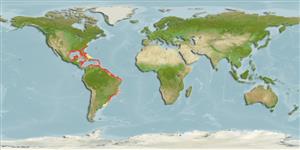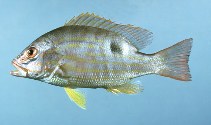Waarneming toevoegen in Fish Watcher
| Native range | All suitable habitat | Point map | Year 2050 |

|
| This map was computer-generated and has not yet been reviewed. |
| Lutjanus synagris AquaMaps Data sources: GBIF OBIS |
Brazil country information
Common names:
Areiacó, Areocó, Ariaco
Occurrence: native
Salinity: marine
Abundance: occasional (usually not seen) | Ref: Feitoza, B.M., R.S. Rosa and L.A. Rocha, 2005
Importance: commercial | Ref: Barreto, T.M.R.R., K.M.F. Freire, J.J.C. Reis-Júnior, L.C. Rosa, A. Carvalho-Filho and M.M. Rotundo, 2018
Aquaculture: | Ref:
Regulations: | Ref:
Uses: no uses
Comments: Ranges from Paraíba south to São Paulo, including Manuel Luiz Reefs and Zumbi Reefs (Ref. 57756); reported to reach the southernmost tip of the Bombinhas Peninsula, Santa Catarina (Ref. 55758). Also Ref. 55, 13442, 26938. Caught by shrimp trawl in Pirambu, Sergipe (Ref. 118626).
National Checklist:
Country Information: https://www.cia.gov/library/publications/resources/the-world-factbook/geos/br.html
National Fisheries Authority:
Occurrences: Occurrences Point map
Main Ref: Floeter, S.R., J.L. Gasparini, L.A. Rocha, C.E.L. Ferreira, C.A. Rangel and B.M. Feitoza, 2003
National Database:
Occurrence: native
Salinity: marine
Abundance: occasional (usually not seen) | Ref: Feitoza, B.M., R.S. Rosa and L.A. Rocha, 2005
Importance: commercial | Ref: Barreto, T.M.R.R., K.M.F. Freire, J.J.C. Reis-Júnior, L.C. Rosa, A. Carvalho-Filho and M.M. Rotundo, 2018
Aquaculture: | Ref:
Regulations: | Ref:
Uses: no uses
Comments: Ranges from Paraíba south to São Paulo, including Manuel Luiz Reefs and Zumbi Reefs (Ref. 57756); reported to reach the southernmost tip of the Bombinhas Peninsula, Santa Catarina (Ref. 55758). Also Ref. 55, 13442, 26938. Caught by shrimp trawl in Pirambu, Sergipe (Ref. 118626).
National Checklist:
Country Information: https://www.cia.gov/library/publications/resources/the-world-factbook/geos/br.html
National Fisheries Authority:
Occurrences: Occurrences Point map
Main Ref: Floeter, S.R., J.L. Gasparini, L.A. Rocha, C.E.L. Ferreira, C.A. Rangel and B.M. Feitoza, 2003
National Database:
Common names from other countries
Classificatie / Names Lokale namen | Synoniemen | Catalog of Fishes(Genus, Soort(en)) | ITIS | CoL | WoRMS | Cloffa
> Eupercaria/misc (Various families in series Eupercaria) > Lutjanidae (Snappers) > Lutjaninae
Etymology: Lutjanus: Malay, ikan lutjan, name of a fish.
More on author: Linnaeus.
Etymology: Lutjanus: Malay, ikan lutjan, name of a fish.
More on author: Linnaeus.
Environment: milieu / climate zone / depth range / distribution range Ecologie
marien rifbewoner; diepte 10 - 400 m (Ref. 9626), usually 21 - 70 m (Ref. 9626). Subtropical; 38°N - 38°S, 98°W - 31°W (Ref. 55253)
Verspreiding Landen | FAO regio's | Ecosystemen | Voorkomen | Point map | Introducties | Faunafri
Western Atlantic: Bermuda (Anderson, pers. comm.) and North Carolina, USA to southeastern Brazil, including Gulf of Mexico and Caribbean Sea (Ref. 9626). Most abundant around the Antilles, on the Campeche Bank, off Panama and the northern coast of South America. Lutjanus ambiguus (Poey, 1860), an intergeneric hybrid with Ocyurus chrysurus (Bloch) as demonstrated by Loftus (1992: Ref. 33006), followed by McEachran &. Fechhelm (2005: Ref. 78464).
Lengte bij maturiteit / Grootte / Gewicht / Leeftijd
Maturity: Lm 23.4, range 16 - 21.5 cm
Max length : 60.0 cm TL mannelijk / geslacht onbekend; (Ref. 40637); common length : 25.0 cm TL mannelijk / geslacht onbekend; (Ref. 55); max. gepubliceerd gewicht: 3.5 kg (Ref. 40637); max. gerapporteerde leeftijd: 10 Jaren (Ref. 3090)
Max length : 60.0 cm TL mannelijk / geslacht onbekend; (Ref. 40637); common length : 25.0 cm TL mannelijk / geslacht onbekend; (Ref. 55); max. gepubliceerd gewicht: 3.5 kg (Ref. 40637); max. gerapporteerde leeftijd: 10 Jaren (Ref. 3090)
Korte beschrijving Determinatiesleutels | Morfologie | Morfometrie
Dorsale stekels (totaal) : 10; Dorsale zachte stralen (totaal) : 12 - 13; Anale stekels: 3; Anale zachte stralen: 8 - 9. Preopercular notch and knob weak. Pectoral fins short, not reaching level of anus. Scale rows on back rising obliquely above lateral line. Back and upper side pink to reddish, with a green tinge and diffused darker vertical bars. The lower sides and belly silvery with a yellow tinge. A series of 8 - 10 horizontal yellow or golden stripes on sides. A diffused black spot mainly above the lateral line and below the anterior portion of the soft dorsal-fin rays.
Adults are found over all types of bottom, but mainly around coral reefs and on vegetated sandy areas. In turbid as well as clear water (Ref. 9710). They often form large aggregations, especially during the breeding season. Feed at night on small fishes, bottom-living crabs, shrimps, worms, gastropods and cephalopods. Good food fish, it is marketed fresh.
Levenscyclus en paargedrag Maturiteit | Voortplanting | Paaien | Eieren | Fecunditeit | Larven
Often form large aggregations, especially during the breeding season.
Hoofdreferentie
Upload your references | Referenties | Coördinator | Medewerkers
Allen, G.R., 1985. FAO Species Catalogue. Vol. 6. Snappers of the world. An annotated and illustrated catalogue of lutjanid species known to date. FAO Fish. Synop. 125(6):208 p. Rome: FAO. (Ref. 55)
Status op de Rode Lijst van het IUCN (Ref. 130435: Version 2024-2)
Gevoelig (NT) ; Date assessed: 10 October 2015
Gebruik door de mens
Visserij: commercieel; sportvis: ja; Aquarium: Publieke aquaria
FAO(visserij: productie; publication : search) | FishSource | Sea Around Us
Meer informatie
Population dynamics
Groeiparameters
Max. ages / sizes
Length-weight rel.
Length-length rel.
Lengtefrequenties
Massaconversie
Rekrutering
Abundantie
Groeiparameters
Max. ages / sizes
Length-weight rel.
Length-length rel.
Lengtefrequenties
Massaconversie
Rekrutering
Abundantie
Life cycle
Voortplanting
Maturiteit
Fecunditeit
Paaien
Spawning aggregations
Eieren
Ontwikkeling van de eieren
Larven
Larvale populatiedynamiek
Voortplanting
Maturiteit
Fecunditeit
Paaien
Spawning aggregations
Eieren
Ontwikkeling van de eieren
Larven
Larvale populatiedynamiek
Anatomy
Kieuwoppervlak
Brain
Otolith
Kieuwoppervlak
Brain
Otolith
Physiology
Body composition
Nutrients
Zuurstofverbruik
Zwemtype
Zwemsnelheid
Visual pigments
Fish sound
Diseases & Parasites
Toxicity (LC50s)
Body composition
Nutrients
Zuurstofverbruik
Zwemtype
Zwemsnelheid
Visual pigments
Fish sound
Diseases & Parasites
Toxicity (LC50s)
Genetics
Genetica
Heterozygosity
Erfelijkheid
Genetica
Heterozygosity
Erfelijkheid
Human related
Aquaculture systems
Aquacultuurprofielen
Kweeklijnen
Ciguatera cases
Stamps, coins, misc.
Aquaculture systems
Aquacultuurprofielen
Kweeklijnen
Ciguatera cases
Stamps, coins, misc.
Tools
E-boek | Veldgids | Determinatiesleutels | Lengtefrequentie Tool | Levenscyclus tool | Verspreidingskaart | Classification Tree
| Catch-MSY |
Speciale rapporten
Bekijk gegevens voor het houden in een aquarium | Bekijk Fact Sheets voor de soort | Bekijk Aquacultuur Fact Sheets
Download XML
Internetbronnen
Aquatic Commons | BHL | Cloffa | Websites from users | Bekijk FishWatcher | CISTI | Catalog of Fishes(Genus, Soort(en)) | DiscoverLife | ECOTOX | Faunafri | Fishtrace | GenBank(genoom, nucleotide) | GloBI | GOBASE | GoMexSI (interaction data) | | Google Books | Google Scholar | Google | IGFA World Record | MitoFish | Nationale databanken | Otolith Atlas of Taiwan Fishes | Publieke aquaria | PubMed | Reef Life Survey | RFE identificatie | Scirus | SeaLifeBase | Tree of Life | Wikipedia(ga naar, zoek) | World Records Freshwater Fishing | Zoological Record
Estimates based on models
Preferred temperature (Ref. 115969): 19.7 - 27.5, mean 24.7 (based on 260 cells).
Fylogenetische diversiteitsindex (Ref. 82804): PD50 = 0.5000 [Uniqueness, from 0.5 = low to 2.0 = high].
Bayesian length-weight: a=0.01514 (0.01359 - 0.01685), b=2.96 (2.94 - 2.98), in cm Total Length, based on LWR estimates for this species (Ref. 93245).
Trofisch niveau (Ref. 69278): 3.8 ±0.2 se; based on diet studies.
Weerstandsvermogen (Ref. 120179): Gemiddeld, minimale populatieverdubbelingstijd 1,4-4,4 jaar (K=0.13-0.26; tm=2; tmax=10).
Prior r = 0.87, 95% CL = 0.57 - 1.30, Based on 6 data-limited stock assessments.
Fishing Vulnerability (Ref. 59153): Moderate vulnerability (37 of 100).
Climate Vulnerability (Ref. 125649): High to very high vulnerability (74 of 100).





